International Joint Ventures & Global Trade
VerifiedAdded on 2020/04/21
|15
|3654
|121
AI Summary
This assignment delves into the complexities of international joint ventures (IJVs) in the context of global business operations. It requires students to research and analyze various facets of IJVs, such as their definition, legal structures, benefits and challenges, and role in facilitating international trade. The assignment likely involves evaluating case studies, comparing different IJV models, and exploring the impact of IJVs on both participating companies and the global market.
Contribute Materials
Your contribution can guide someone’s learning journey. Share your
documents today.
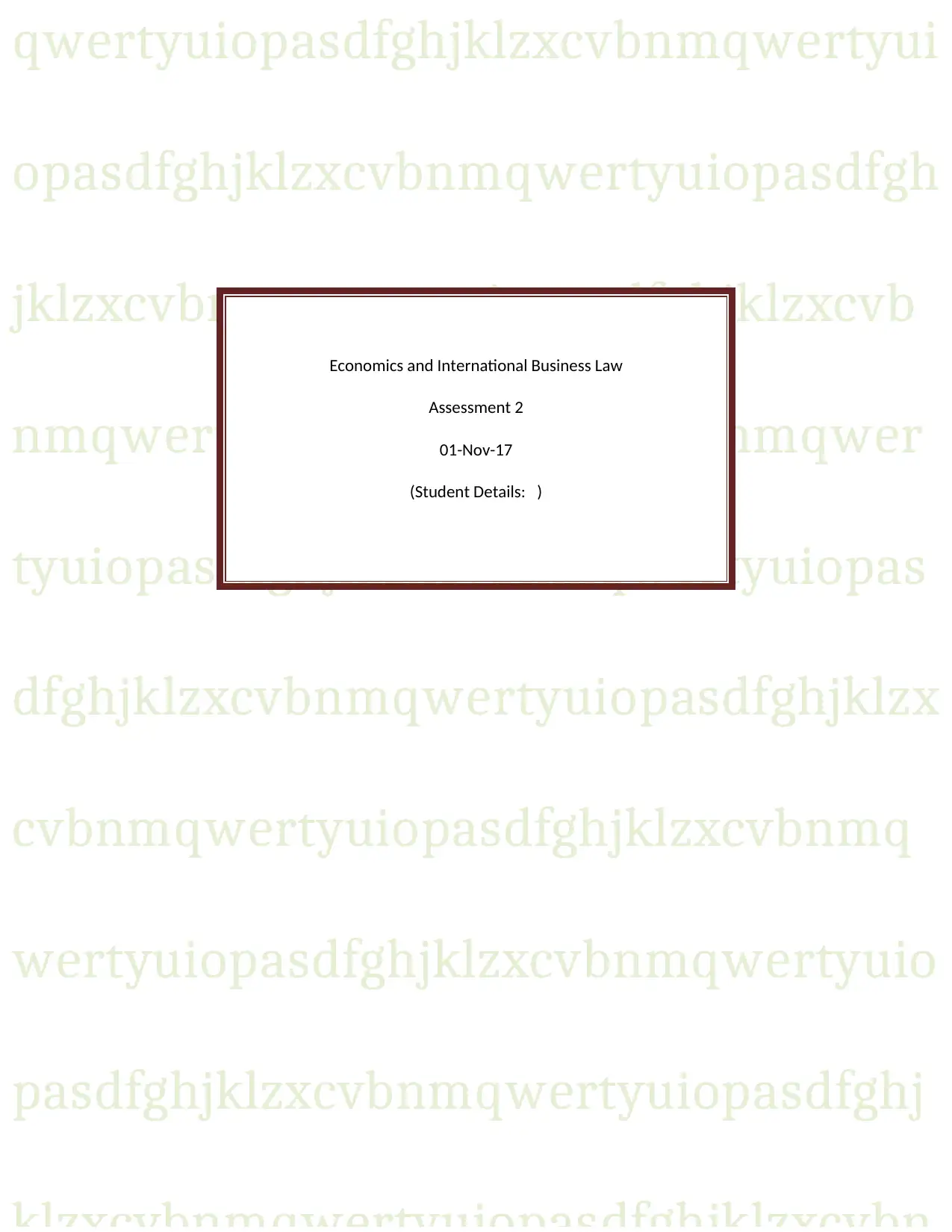
qwertyuiopasdfghjklzxcvbnmqwertyui
opasdfghjklzxcvbnmqwertyuiopasdfgh
jklzxcvbnmqwertyuiopasdfghjklzxcvb
nmqwertyuiopasdfghjklzxcvbnmqwer
tyuiopasdfghjklzxcvbnmqwertyuiopas
dfghjklzxcvbnmqwertyuiopasdfghjklzx
cvbnmqwertyuiopasdfghjklzxcvbnmq
wertyuiopasdfghjklzxcvbnmqwertyuio
pasdfghjklzxcvbnmqwertyuiopasdfghj
Economics and International Business Law
Assessment 2
01-Nov-17
(Student Details: )
opasdfghjklzxcvbnmqwertyuiopasdfgh
jklzxcvbnmqwertyuiopasdfghjklzxcvb
nmqwertyuiopasdfghjklzxcvbnmqwer
tyuiopasdfghjklzxcvbnmqwertyuiopas
dfghjklzxcvbnmqwertyuiopasdfghjklzx
cvbnmqwertyuiopasdfghjklzxcvbnmq
wertyuiopasdfghjklzxcvbnmqwertyuio
pasdfghjklzxcvbnmqwertyuiopasdfghj
Economics and International Business Law
Assessment 2
01-Nov-17
(Student Details: )
Secure Best Marks with AI Grader
Need help grading? Try our AI Grader for instant feedback on your assignments.
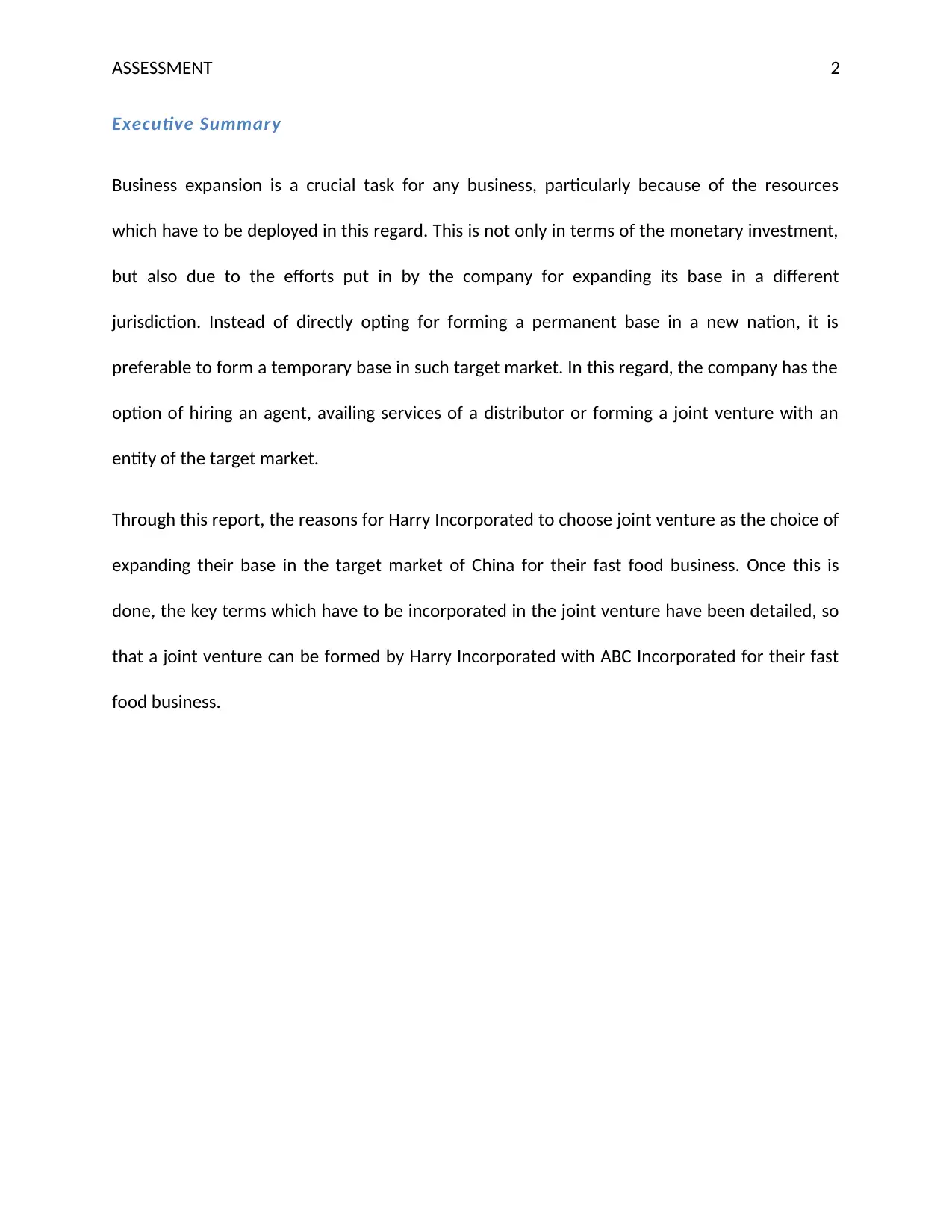
ASSESSMENT 2
Executive Summary
Business expansion is a crucial task for any business, particularly because of the resources
which have to be deployed in this regard. This is not only in terms of the monetary investment,
but also due to the efforts put in by the company for expanding its base in a different
jurisdiction. Instead of directly opting for forming a permanent base in a new nation, it is
preferable to form a temporary base in such target market. In this regard, the company has the
option of hiring an agent, availing services of a distributor or forming a joint venture with an
entity of the target market.
Through this report, the reasons for Harry Incorporated to choose joint venture as the choice of
expanding their base in the target market of China for their fast food business. Once this is
done, the key terms which have to be incorporated in the joint venture have been detailed, so
that a joint venture can be formed by Harry Incorporated with ABC Incorporated for their fast
food business.
Executive Summary
Business expansion is a crucial task for any business, particularly because of the resources
which have to be deployed in this regard. This is not only in terms of the monetary investment,
but also due to the efforts put in by the company for expanding its base in a different
jurisdiction. Instead of directly opting for forming a permanent base in a new nation, it is
preferable to form a temporary base in such target market. In this regard, the company has the
option of hiring an agent, availing services of a distributor or forming a joint venture with an
entity of the target market.
Through this report, the reasons for Harry Incorporated to choose joint venture as the choice of
expanding their base in the target market of China for their fast food business. Once this is
done, the key terms which have to be incorporated in the joint venture have been detailed, so
that a joint venture can be formed by Harry Incorporated with ABC Incorporated for their fast
food business.

ASSESSMENT 3
Table of Contents
Introduction...................................................................................................................................4
Agency, Distributor and Joint Venture...........................................................................................4
Agency/ Distributor- An Alternative.......................................................................................... 5
Joint Venture- Most Suitable.....................................................................................................7
Key Terms of JV Agreement...........................................................................................................8
Conclusion................................................................................................................................... 11
References................................................................................................................................... 12
Table of Contents
Introduction...................................................................................................................................4
Agency, Distributor and Joint Venture...........................................................................................4
Agency/ Distributor- An Alternative.......................................................................................... 5
Joint Venture- Most Suitable.....................................................................................................7
Key Terms of JV Agreement...........................................................................................................8
Conclusion................................................................................................................................... 11
References................................................................................................................................... 12

ASSESSMENT 4
Introduction
When an entity wishes to expand their business, there are a number of crucial factors which
have to be given due consideration, before opting for a medium of expansion (Chan, 2006). A
company can choose to expand its business by hiring an agent of other nation, hiring a
distributor to sell their products, or can opt for the formation of a joint venture with an entity
of the nation in which the company wants to expand itself. Harry Incorporated (fictional
company) is faced with this very dilemma of which method they need to opt for expanding their
business in China.
Harry Incorporated is expanding its based in China, where the long term plan of the company is
to form a branch in China, to tap its growing market. The reason for opting for China is that the
nation has the largest population in the world, let alone the Eastern nations, and for a fast food
company like ours, a higher population raises the prospects of profits (Hackett, 2014). However,
instead of directly setting base in China, the company wants to evaluate the conditions present
in the nation. And so, a dilemma has been raised on which method the company should opt for
as its beginning in China. Thus, the report presents an evaluation of the three options available
with it for expanding in China. Once this is done, the key requirements of establishing such
option would be highlighted.
Introduction
When an entity wishes to expand their business, there are a number of crucial factors which
have to be given due consideration, before opting for a medium of expansion (Chan, 2006). A
company can choose to expand its business by hiring an agent of other nation, hiring a
distributor to sell their products, or can opt for the formation of a joint venture with an entity
of the nation in which the company wants to expand itself. Harry Incorporated (fictional
company) is faced with this very dilemma of which method they need to opt for expanding their
business in China.
Harry Incorporated is expanding its based in China, where the long term plan of the company is
to form a branch in China, to tap its growing market. The reason for opting for China is that the
nation has the largest population in the world, let alone the Eastern nations, and for a fast food
company like ours, a higher population raises the prospects of profits (Hackett, 2014). However,
instead of directly setting base in China, the company wants to evaluate the conditions present
in the nation. And so, a dilemma has been raised on which method the company should opt for
as its beginning in China. Thus, the report presents an evaluation of the three options available
with it for expanding in China. Once this is done, the key requirements of establishing such
option would be highlighted.
Paraphrase This Document
Need a fresh take? Get an instant paraphrase of this document with our AI Paraphraser
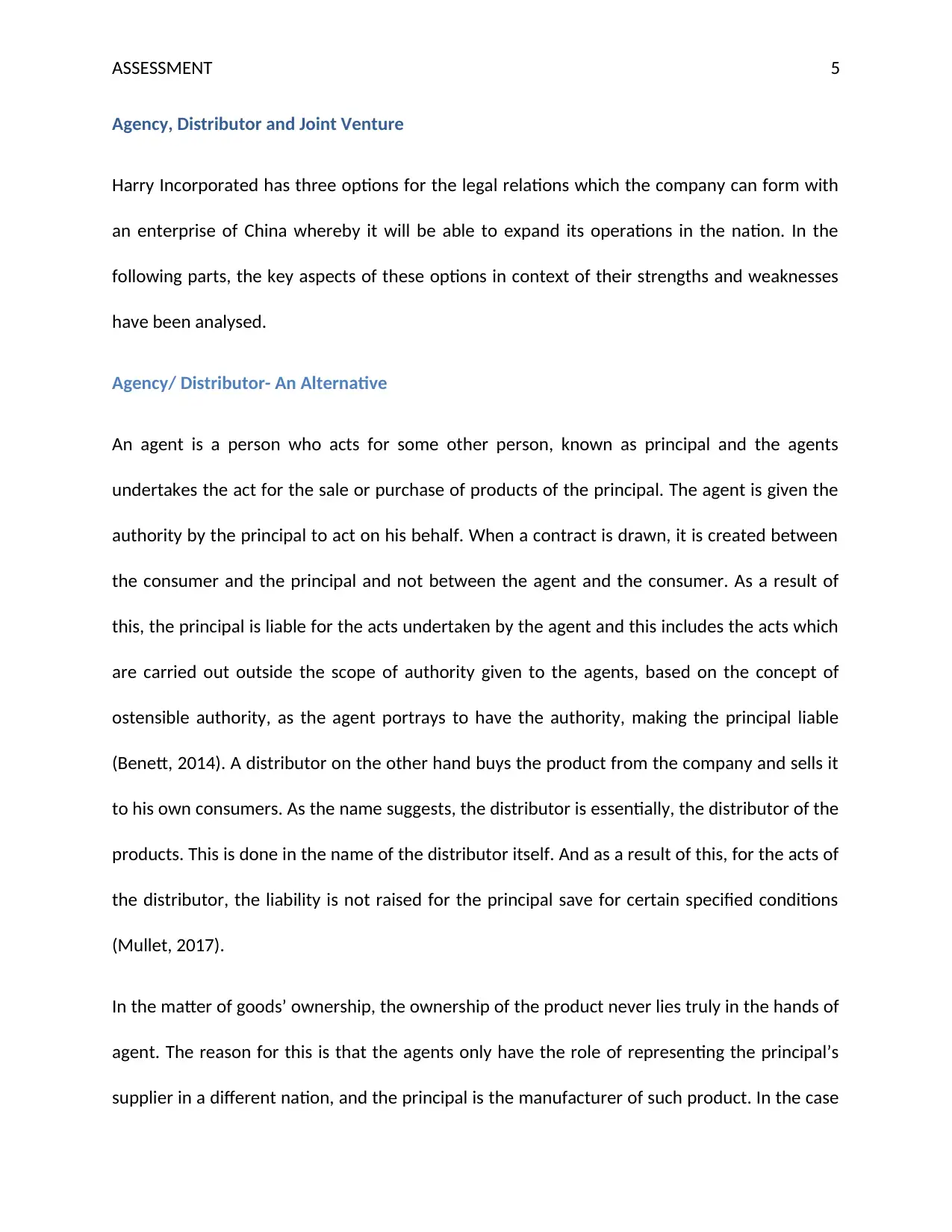
ASSESSMENT 5
Agency, Distributor and Joint Venture
Harry Incorporated has three options for the legal relations which the company can form with
an enterprise of China whereby it will be able to expand its operations in the nation. In the
following parts, the key aspects of these options in context of their strengths and weaknesses
have been analysed.
Agency/ Distributor- An Alternative
An agent is a person who acts for some other person, known as principal and the agents
undertakes the act for the sale or purchase of products of the principal. The agent is given the
authority by the principal to act on his behalf. When a contract is drawn, it is created between
the consumer and the principal and not between the agent and the consumer. As a result of
this, the principal is liable for the acts undertaken by the agent and this includes the acts which
are carried out outside the scope of authority given to the agents, based on the concept of
ostensible authority, as the agent portrays to have the authority, making the principal liable
(Benett, 2014). A distributor on the other hand buys the product from the company and sells it
to his own consumers. As the name suggests, the distributor is essentially, the distributor of the
products. This is done in the name of the distributor itself. And as a result of this, for the acts of
the distributor, the liability is not raised for the principal save for certain specified conditions
(Mullet, 2017).
In the matter of goods’ ownership, the ownership of the product never lies truly in the hands of
agent. The reason for this is that the agents only have the role of representing the principal’s
supplier in a different nation, and the principal is the manufacturer of such product. In the case
Agency, Distributor and Joint Venture
Harry Incorporated has three options for the legal relations which the company can form with
an enterprise of China whereby it will be able to expand its operations in the nation. In the
following parts, the key aspects of these options in context of their strengths and weaknesses
have been analysed.
Agency/ Distributor- An Alternative
An agent is a person who acts for some other person, known as principal and the agents
undertakes the act for the sale or purchase of products of the principal. The agent is given the
authority by the principal to act on his behalf. When a contract is drawn, it is created between
the consumer and the principal and not between the agent and the consumer. As a result of
this, the principal is liable for the acts undertaken by the agent and this includes the acts which
are carried out outside the scope of authority given to the agents, based on the concept of
ostensible authority, as the agent portrays to have the authority, making the principal liable
(Benett, 2014). A distributor on the other hand buys the product from the company and sells it
to his own consumers. As the name suggests, the distributor is essentially, the distributor of the
products. This is done in the name of the distributor itself. And as a result of this, for the acts of
the distributor, the liability is not raised for the principal save for certain specified conditions
(Mullet, 2017).
In the matter of goods’ ownership, the ownership of the product never lies truly in the hands of
agent. The reason for this is that the agents only have the role of representing the principal’s
supplier in a different nation, and the principal is the manufacturer of such product. In the case

ASSESSMENT 6
of distributors, the goods are purchased by the distributor from the manufacturer and then this
product is sold in the international market, to the customers of the manufacturer. Owing to
these reasons, the distributor obtains the product’s title. There is also a choice with the
distributors on the target audience to which they want to sell their products. Hence, they can
choose to make the sale to retailers, to wholesaler, and even through e-portals to other
audience (Murphy Marketing, 2016).
When it comes to the agency, the exporting party, i.e., the supplier has the responsibility of
making payment to the agent, and is usually in the form of commission based on the sale of
product, achievement of targets or on the sale value of the product. The exporting party fixes
the price of sale on the basis of inputs, which the agents provide to the seller, and this relates
to the local or domestic market (Singh, 2015). When it comes to the distributors, the
distributors earn their revenue by adding margins to the price of the product. This result in the
prices of the product being raised and in order to bring this down, the principal has to absorb
the margins of distributors in order to avoid the prices of the product from being raised. So, to
avoid decline in the customers, the principal forgoes a part of their profits. Also, the fee given
to the distributor is quite high in comparison to the compensation given to the agents (Alliance
Expert, 2017).
The agents are responsible for getting the orders for the exports and in return for this service,
the agents collects the payment from the consumers, and also delivers the invoices as a
representative of the exporter. Hence, the marketing operations of agents relate to the sales
activities and the network development. On the other hand, for the distributors, the duty of
of distributors, the goods are purchased by the distributor from the manufacturer and then this
product is sold in the international market, to the customers of the manufacturer. Owing to
these reasons, the distributor obtains the product’s title. There is also a choice with the
distributors on the target audience to which they want to sell their products. Hence, they can
choose to make the sale to retailers, to wholesaler, and even through e-portals to other
audience (Murphy Marketing, 2016).
When it comes to the agency, the exporting party, i.e., the supplier has the responsibility of
making payment to the agent, and is usually in the form of commission based on the sale of
product, achievement of targets or on the sale value of the product. The exporting party fixes
the price of sale on the basis of inputs, which the agents provide to the seller, and this relates
to the local or domestic market (Singh, 2015). When it comes to the distributors, the
distributors earn their revenue by adding margins to the price of the product. This result in the
prices of the product being raised and in order to bring this down, the principal has to absorb
the margins of distributors in order to avoid the prices of the product from being raised. So, to
avoid decline in the customers, the principal forgoes a part of their profits. Also, the fee given
to the distributor is quite high in comparison to the compensation given to the agents (Alliance
Expert, 2017).
The agents are responsible for getting the orders for the exports and in return for this service,
the agents collects the payment from the consumers, and also delivers the invoices as a
representative of the exporter. Hence, the marketing operations of agents relate to the sales
activities and the network development. On the other hand, for the distributors, the duty of
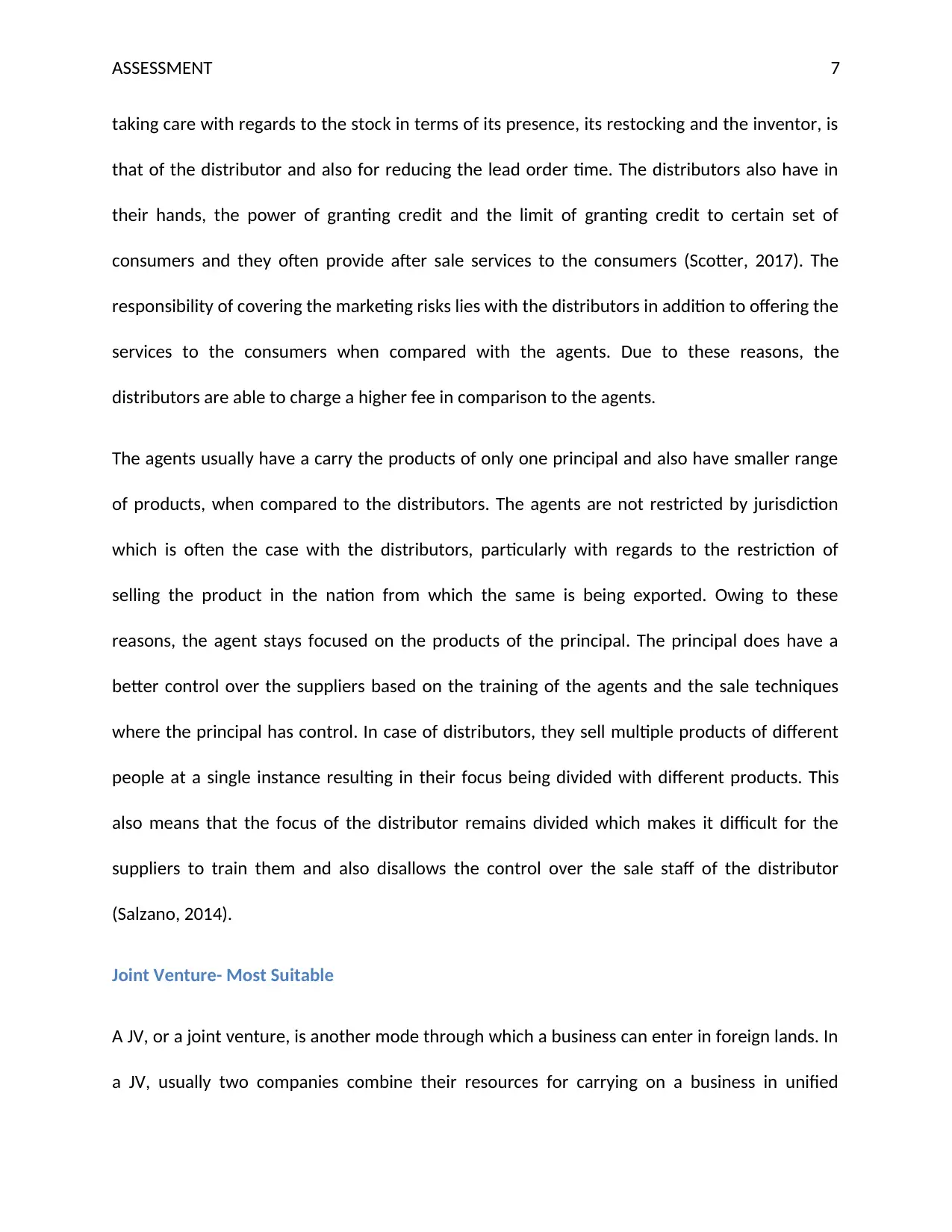
ASSESSMENT 7
taking care with regards to the stock in terms of its presence, its restocking and the inventor, is
that of the distributor and also for reducing the lead order time. The distributors also have in
their hands, the power of granting credit and the limit of granting credit to certain set of
consumers and they often provide after sale services to the consumers (Scotter, 2017). The
responsibility of covering the marketing risks lies with the distributors in addition to offering the
services to the consumers when compared with the agents. Due to these reasons, the
distributors are able to charge a higher fee in comparison to the agents.
The agents usually have a carry the products of only one principal and also have smaller range
of products, when compared to the distributors. The agents are not restricted by jurisdiction
which is often the case with the distributors, particularly with regards to the restriction of
selling the product in the nation from which the same is being exported. Owing to these
reasons, the agent stays focused on the products of the principal. The principal does have a
better control over the suppliers based on the training of the agents and the sale techniques
where the principal has control. In case of distributors, they sell multiple products of different
people at a single instance resulting in their focus being divided with different products. This
also means that the focus of the distributor remains divided which makes it difficult for the
suppliers to train them and also disallows the control over the sale staff of the distributor
(Salzano, 2014).
Joint Venture- Most Suitable
A JV, or a joint venture, is another mode through which a business can enter in foreign lands. In
a JV, usually two companies combine their resources for carrying on a business in unified
taking care with regards to the stock in terms of its presence, its restocking and the inventor, is
that of the distributor and also for reducing the lead order time. The distributors also have in
their hands, the power of granting credit and the limit of granting credit to certain set of
consumers and they often provide after sale services to the consumers (Scotter, 2017). The
responsibility of covering the marketing risks lies with the distributors in addition to offering the
services to the consumers when compared with the agents. Due to these reasons, the
distributors are able to charge a higher fee in comparison to the agents.
The agents usually have a carry the products of only one principal and also have smaller range
of products, when compared to the distributors. The agents are not restricted by jurisdiction
which is often the case with the distributors, particularly with regards to the restriction of
selling the product in the nation from which the same is being exported. Owing to these
reasons, the agent stays focused on the products of the principal. The principal does have a
better control over the suppliers based on the training of the agents and the sale techniques
where the principal has control. In case of distributors, they sell multiple products of different
people at a single instance resulting in their focus being divided with different products. This
also means that the focus of the distributor remains divided which makes it difficult for the
suppliers to train them and also disallows the control over the sale staff of the distributor
(Salzano, 2014).
Joint Venture- Most Suitable
A JV, or a joint venture, is another mode through which a business can enter in foreign lands. In
a JV, usually two companies combine their resources for carrying on a business in unified
Secure Best Marks with AI Grader
Need help grading? Try our AI Grader for instant feedback on your assignments.
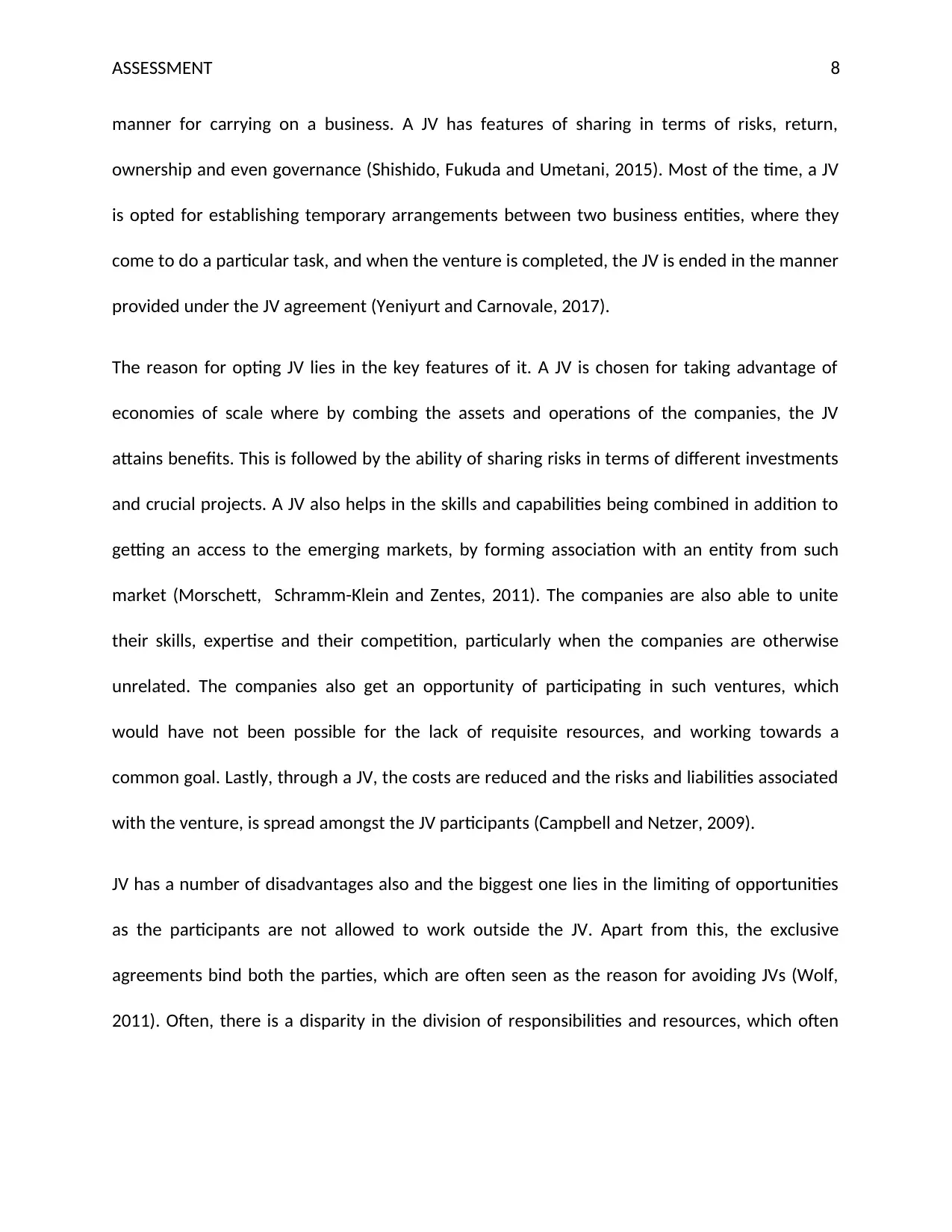
ASSESSMENT 8
manner for carrying on a business. A JV has features of sharing in terms of risks, return,
ownership and even governance (Shishido, Fukuda and Umetani, 2015). Most of the time, a JV
is opted for establishing temporary arrangements between two business entities, where they
come to do a particular task, and when the venture is completed, the JV is ended in the manner
provided under the JV agreement (Yeniyurt and Carnovale, 2017).
The reason for opting JV lies in the key features of it. A JV is chosen for taking advantage of
economies of scale where by combing the assets and operations of the companies, the JV
attains benefits. This is followed by the ability of sharing risks in terms of different investments
and crucial projects. A JV also helps in the skills and capabilities being combined in addition to
getting an access to the emerging markets, by forming association with an entity from such
market (Morschett, Schramm-Klein and Zentes, 2011). The companies are also able to unite
their skills, expertise and their competition, particularly when the companies are otherwise
unrelated. The companies also get an opportunity of participating in such ventures, which
would have not been possible for the lack of requisite resources, and working towards a
common goal. Lastly, through a JV, the costs are reduced and the risks and liabilities associated
with the venture, is spread amongst the JV participants (Campbell and Netzer, 2009).
JV has a number of disadvantages also and the biggest one lies in the limiting of opportunities
as the participants are not allowed to work outside the JV. Apart from this, the exclusive
agreements bind both the parties, which are often seen as the reason for avoiding JVs (Wolf,
2011). Often, there is a disparity in the division of responsibilities and resources, which often
manner for carrying on a business. A JV has features of sharing in terms of risks, return,
ownership and even governance (Shishido, Fukuda and Umetani, 2015). Most of the time, a JV
is opted for establishing temporary arrangements between two business entities, where they
come to do a particular task, and when the venture is completed, the JV is ended in the manner
provided under the JV agreement (Yeniyurt and Carnovale, 2017).
The reason for opting JV lies in the key features of it. A JV is chosen for taking advantage of
economies of scale where by combing the assets and operations of the companies, the JV
attains benefits. This is followed by the ability of sharing risks in terms of different investments
and crucial projects. A JV also helps in the skills and capabilities being combined in addition to
getting an access to the emerging markets, by forming association with an entity from such
market (Morschett, Schramm-Klein and Zentes, 2011). The companies are also able to unite
their skills, expertise and their competition, particularly when the companies are otherwise
unrelated. The companies also get an opportunity of participating in such ventures, which
would have not been possible for the lack of requisite resources, and working towards a
common goal. Lastly, through a JV, the costs are reduced and the risks and liabilities associated
with the venture, is spread amongst the JV participants (Campbell and Netzer, 2009).
JV has a number of disadvantages also and the biggest one lies in the limiting of opportunities
as the participants are not allowed to work outside the JV. Apart from this, the exclusive
agreements bind both the parties, which are often seen as the reason for avoiding JVs (Wolf,
2011). Often, there is a disparity in the division of responsibilities and resources, which often
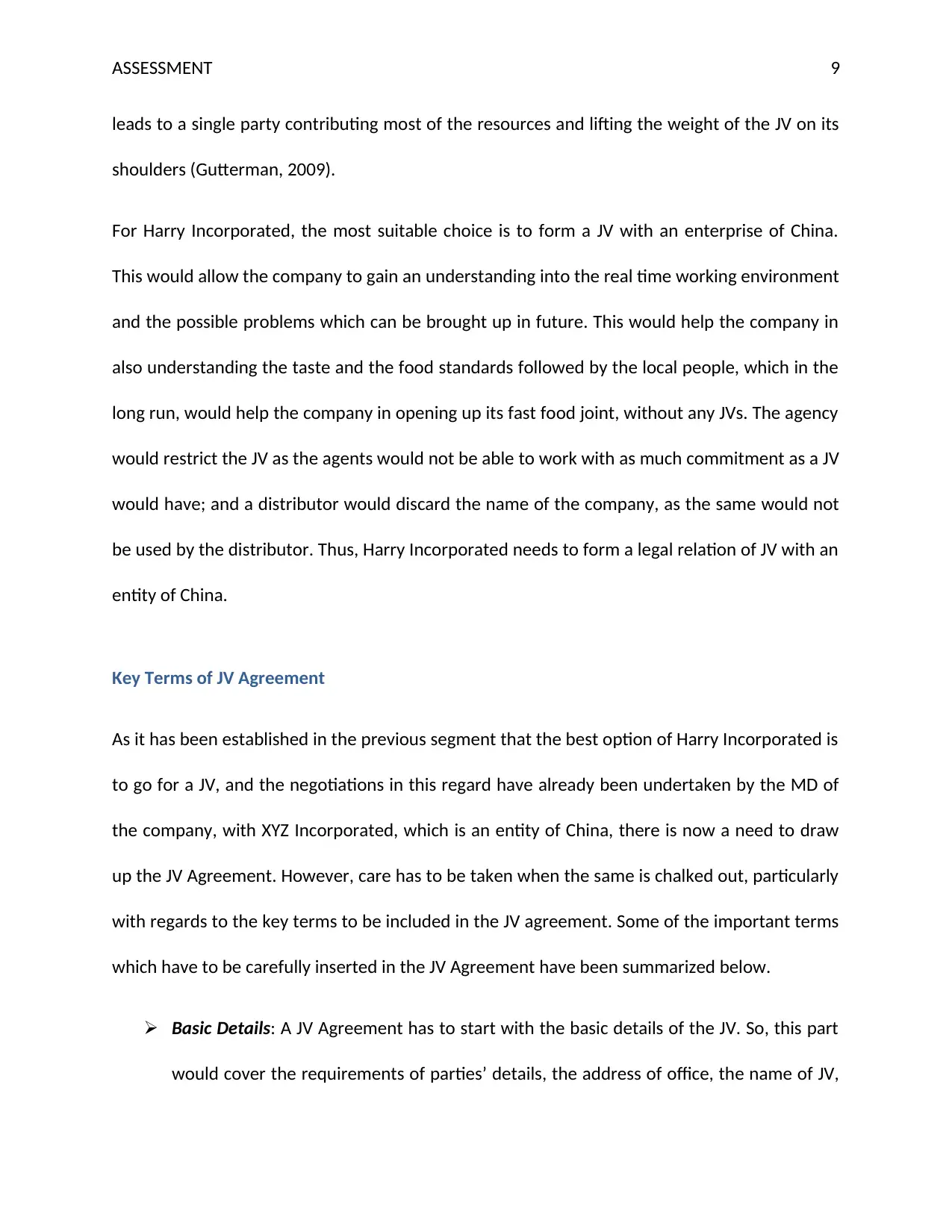
ASSESSMENT 9
leads to a single party contributing most of the resources and lifting the weight of the JV on its
shoulders (Gutterman, 2009).
For Harry Incorporated, the most suitable choice is to form a JV with an enterprise of China.
This would allow the company to gain an understanding into the real time working environment
and the possible problems which can be brought up in future. This would help the company in
also understanding the taste and the food standards followed by the local people, which in the
long run, would help the company in opening up its fast food joint, without any JVs. The agency
would restrict the JV as the agents would not be able to work with as much commitment as a JV
would have; and a distributor would discard the name of the company, as the same would not
be used by the distributor. Thus, Harry Incorporated needs to form a legal relation of JV with an
entity of China.
Key Terms of JV Agreement
As it has been established in the previous segment that the best option of Harry Incorporated is
to go for a JV, and the negotiations in this regard have already been undertaken by the MD of
the company, with XYZ Incorporated, which is an entity of China, there is now a need to draw
up the JV Agreement. However, care has to be taken when the same is chalked out, particularly
with regards to the key terms to be included in the JV agreement. Some of the important terms
which have to be carefully inserted in the JV Agreement have been summarized below.
Basic Details: A JV Agreement has to start with the basic details of the JV. So, this part
would cover the requirements of parties’ details, the address of office, the name of JV,
leads to a single party contributing most of the resources and lifting the weight of the JV on its
shoulders (Gutterman, 2009).
For Harry Incorporated, the most suitable choice is to form a JV with an enterprise of China.
This would allow the company to gain an understanding into the real time working environment
and the possible problems which can be brought up in future. This would help the company in
also understanding the taste and the food standards followed by the local people, which in the
long run, would help the company in opening up its fast food joint, without any JVs. The agency
would restrict the JV as the agents would not be able to work with as much commitment as a JV
would have; and a distributor would discard the name of the company, as the same would not
be used by the distributor. Thus, Harry Incorporated needs to form a legal relation of JV with an
entity of China.
Key Terms of JV Agreement
As it has been established in the previous segment that the best option of Harry Incorporated is
to go for a JV, and the negotiations in this regard have already been undertaken by the MD of
the company, with XYZ Incorporated, which is an entity of China, there is now a need to draw
up the JV Agreement. However, care has to be taken when the same is chalked out, particularly
with regards to the key terms to be included in the JV agreement. Some of the important terms
which have to be carefully inserted in the JV Agreement have been summarized below.
Basic Details: A JV Agreement has to start with the basic details of the JV. So, this part
would cover the requirements of parties’ details, the address of office, the name of JV,
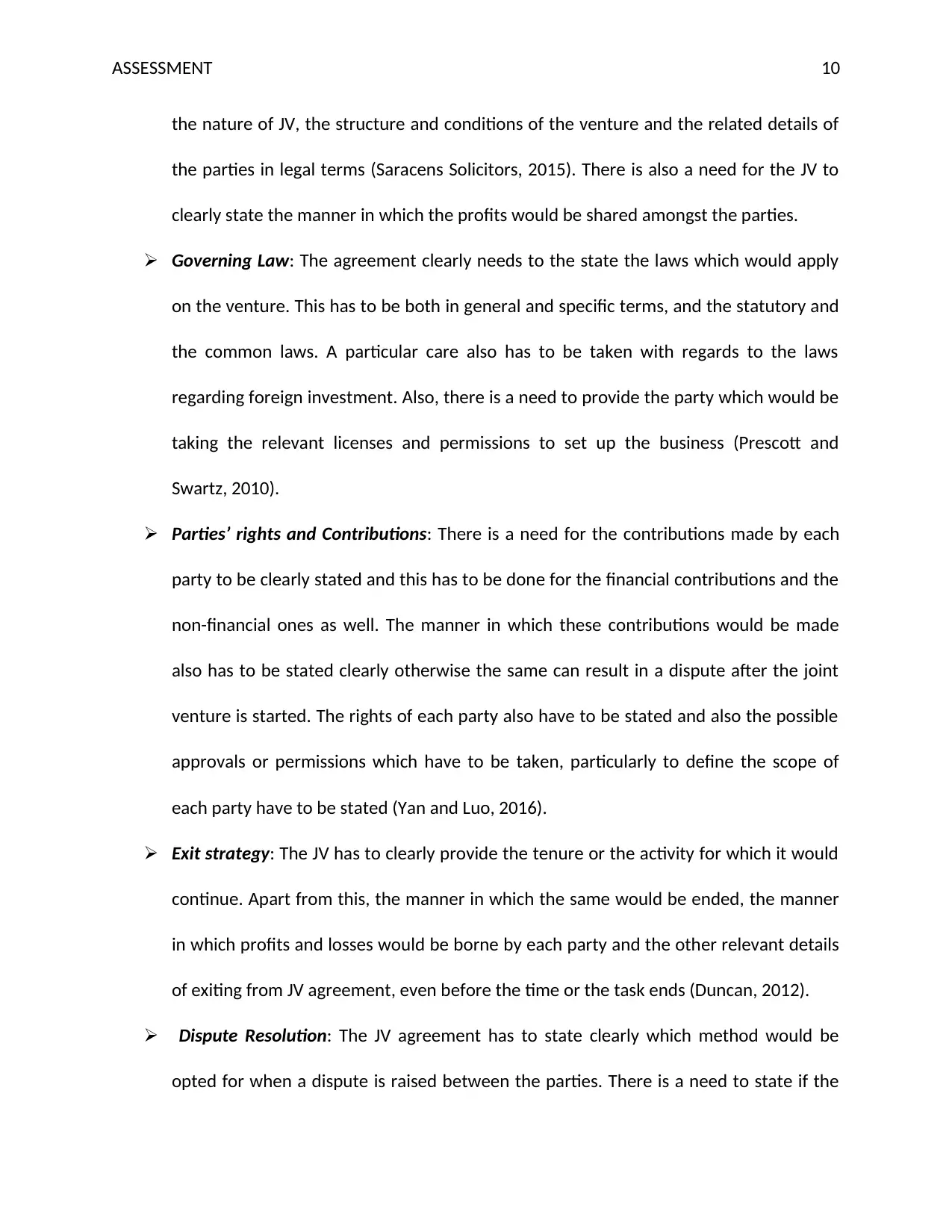
ASSESSMENT 10
the nature of JV, the structure and conditions of the venture and the related details of
the parties in legal terms (Saracens Solicitors, 2015). There is also a need for the JV to
clearly state the manner in which the profits would be shared amongst the parties.
Governing Law: The agreement clearly needs to the state the laws which would apply
on the venture. This has to be both in general and specific terms, and the statutory and
the common laws. A particular care also has to be taken with regards to the laws
regarding foreign investment. Also, there is a need to provide the party which would be
taking the relevant licenses and permissions to set up the business (Prescott and
Swartz, 2010).
Parties’ rights and Contributions: There is a need for the contributions made by each
party to be clearly stated and this has to be done for the financial contributions and the
non-financial ones as well. The manner in which these contributions would be made
also has to be stated clearly otherwise the same can result in a dispute after the joint
venture is started. The rights of each party also have to be stated and also the possible
approvals or permissions which have to be taken, particularly to define the scope of
each party have to be stated (Yan and Luo, 2016).
Exit strategy: The JV has to clearly provide the tenure or the activity for which it would
continue. Apart from this, the manner in which the same would be ended, the manner
in which profits and losses would be borne by each party and the other relevant details
of exiting from JV agreement, even before the time or the task ends (Duncan, 2012).
Dispute Resolution: The JV agreement has to state clearly which method would be
opted for when a dispute is raised between the parties. There is a need to state if the
the nature of JV, the structure and conditions of the venture and the related details of
the parties in legal terms (Saracens Solicitors, 2015). There is also a need for the JV to
clearly state the manner in which the profits would be shared amongst the parties.
Governing Law: The agreement clearly needs to the state the laws which would apply
on the venture. This has to be both in general and specific terms, and the statutory and
the common laws. A particular care also has to be taken with regards to the laws
regarding foreign investment. Also, there is a need to provide the party which would be
taking the relevant licenses and permissions to set up the business (Prescott and
Swartz, 2010).
Parties’ rights and Contributions: There is a need for the contributions made by each
party to be clearly stated and this has to be done for the financial contributions and the
non-financial ones as well. The manner in which these contributions would be made
also has to be stated clearly otherwise the same can result in a dispute after the joint
venture is started. The rights of each party also have to be stated and also the possible
approvals or permissions which have to be taken, particularly to define the scope of
each party have to be stated (Yan and Luo, 2016).
Exit strategy: The JV has to clearly provide the tenure or the activity for which it would
continue. Apart from this, the manner in which the same would be ended, the manner
in which profits and losses would be borne by each party and the other relevant details
of exiting from JV agreement, even before the time or the task ends (Duncan, 2012).
Dispute Resolution: The JV agreement has to state clearly which method would be
opted for when a dispute is raised between the parties. There is a need to state if the
Paraphrase This Document
Need a fresh take? Get an instant paraphrase of this document with our AI Paraphraser
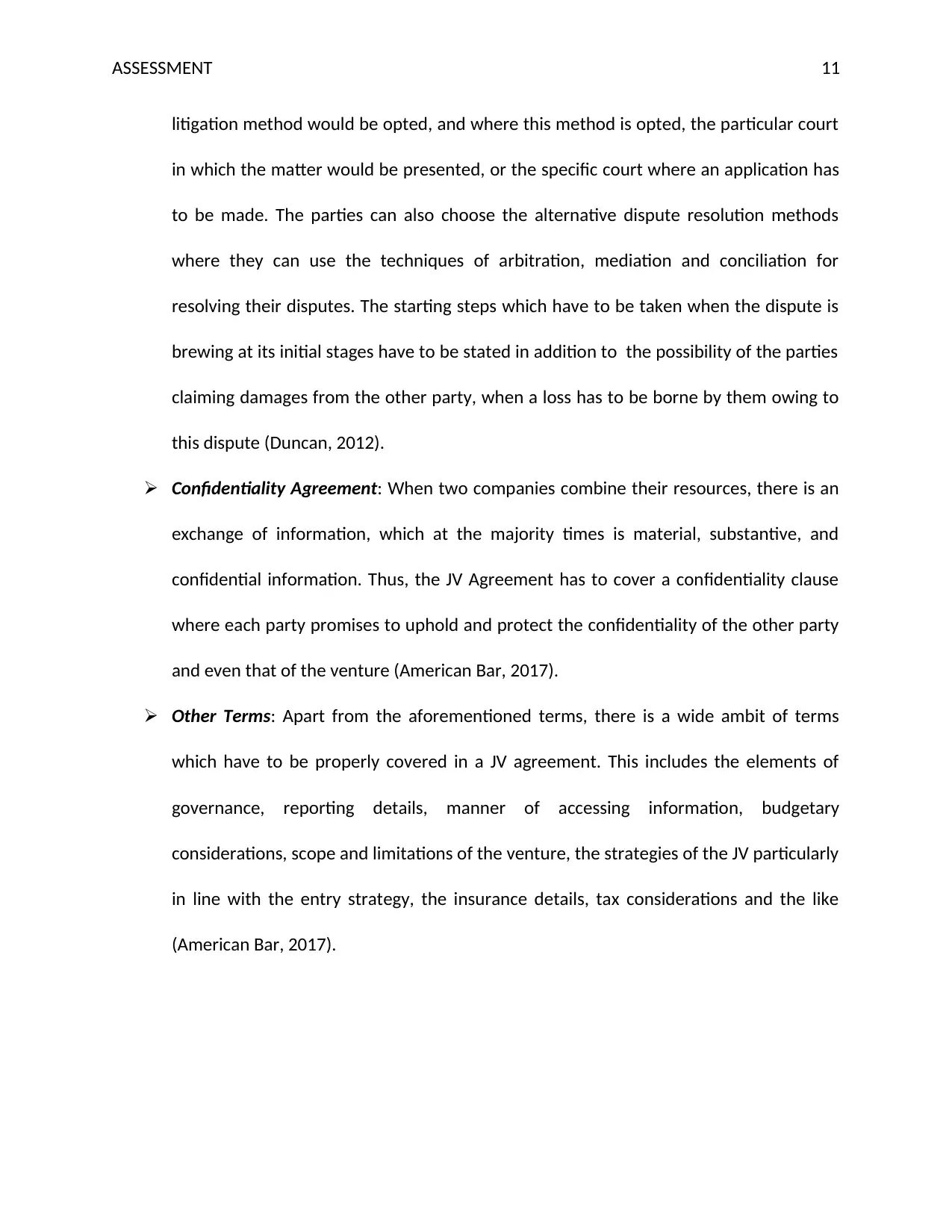
ASSESSMENT 11
litigation method would be opted, and where this method is opted, the particular court
in which the matter would be presented, or the specific court where an application has
to be made. The parties can also choose the alternative dispute resolution methods
where they can use the techniques of arbitration, mediation and conciliation for
resolving their disputes. The starting steps which have to be taken when the dispute is
brewing at its initial stages have to be stated in addition to the possibility of the parties
claiming damages from the other party, when a loss has to be borne by them owing to
this dispute (Duncan, 2012).
Confidentiality Agreement: When two companies combine their resources, there is an
exchange of information, which at the majority times is material, substantive, and
confidential information. Thus, the JV Agreement has to cover a confidentiality clause
where each party promises to uphold and protect the confidentiality of the other party
and even that of the venture (American Bar, 2017).
Other Terms: Apart from the aforementioned terms, there is a wide ambit of terms
which have to be properly covered in a JV agreement. This includes the elements of
governance, reporting details, manner of accessing information, budgetary
considerations, scope and limitations of the venture, the strategies of the JV particularly
in line with the entry strategy, the insurance details, tax considerations and the like
(American Bar, 2017).
litigation method would be opted, and where this method is opted, the particular court
in which the matter would be presented, or the specific court where an application has
to be made. The parties can also choose the alternative dispute resolution methods
where they can use the techniques of arbitration, mediation and conciliation for
resolving their disputes. The starting steps which have to be taken when the dispute is
brewing at its initial stages have to be stated in addition to the possibility of the parties
claiming damages from the other party, when a loss has to be borne by them owing to
this dispute (Duncan, 2012).
Confidentiality Agreement: When two companies combine their resources, there is an
exchange of information, which at the majority times is material, substantive, and
confidential information. Thus, the JV Agreement has to cover a confidentiality clause
where each party promises to uphold and protect the confidentiality of the other party
and even that of the venture (American Bar, 2017).
Other Terms: Apart from the aforementioned terms, there is a wide ambit of terms
which have to be properly covered in a JV agreement. This includes the elements of
governance, reporting details, manner of accessing information, budgetary
considerations, scope and limitations of the venture, the strategies of the JV particularly
in line with the entry strategy, the insurance details, tax considerations and the like
(American Bar, 2017).
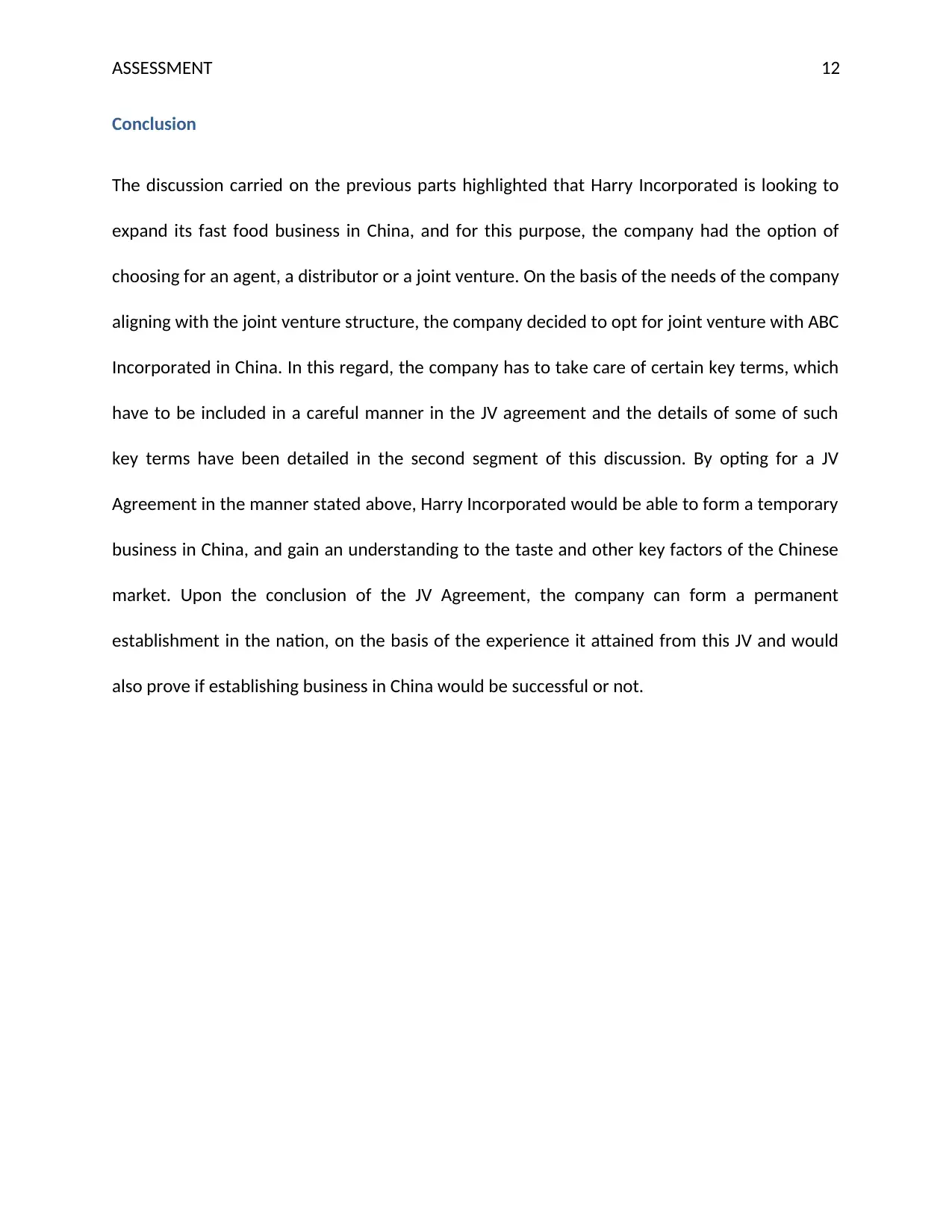
ASSESSMENT 12
Conclusion
The discussion carried on the previous parts highlighted that Harry Incorporated is looking to
expand its fast food business in China, and for this purpose, the company had the option of
choosing for an agent, a distributor or a joint venture. On the basis of the needs of the company
aligning with the joint venture structure, the company decided to opt for joint venture with ABC
Incorporated in China. In this regard, the company has to take care of certain key terms, which
have to be included in a careful manner in the JV agreement and the details of some of such
key terms have been detailed in the second segment of this discussion. By opting for a JV
Agreement in the manner stated above, Harry Incorporated would be able to form a temporary
business in China, and gain an understanding to the taste and other key factors of the Chinese
market. Upon the conclusion of the JV Agreement, the company can form a permanent
establishment in the nation, on the basis of the experience it attained from this JV and would
also prove if establishing business in China would be successful or not.
Conclusion
The discussion carried on the previous parts highlighted that Harry Incorporated is looking to
expand its fast food business in China, and for this purpose, the company had the option of
choosing for an agent, a distributor or a joint venture. On the basis of the needs of the company
aligning with the joint venture structure, the company decided to opt for joint venture with ABC
Incorporated in China. In this regard, the company has to take care of certain key terms, which
have to be included in a careful manner in the JV agreement and the details of some of such
key terms have been detailed in the second segment of this discussion. By opting for a JV
Agreement in the manner stated above, Harry Incorporated would be able to form a temporary
business in China, and gain an understanding to the taste and other key factors of the Chinese
market. Upon the conclusion of the JV Agreement, the company can form a permanent
establishment in the nation, on the basis of the experience it attained from this JV and would
also prove if establishing business in China would be successful or not.
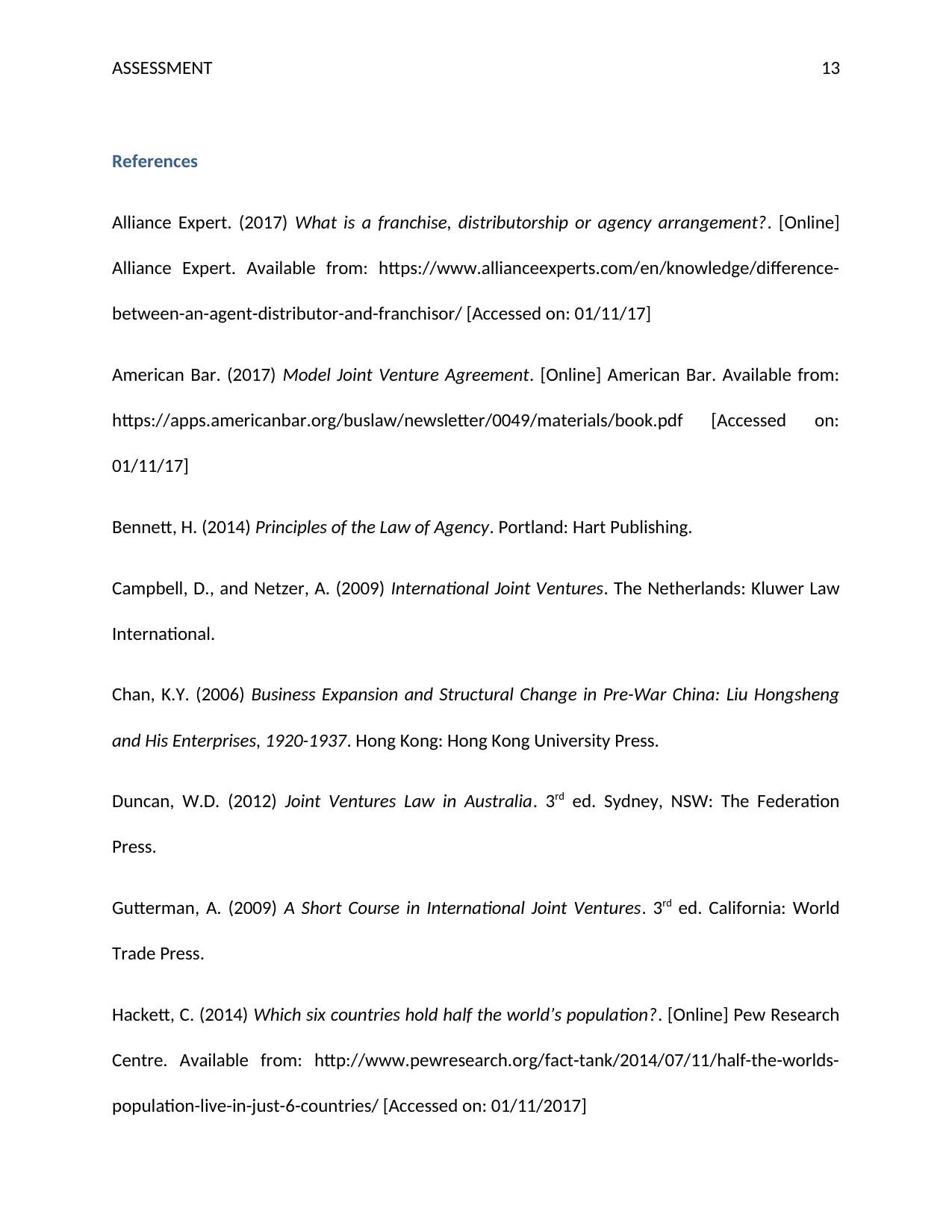
ASSESSMENT 13
References
Alliance Expert. (2017) What is a franchise, distributorship or agency arrangement?. [Online]
Alliance Expert. Available from: https://www.allianceexperts.com/en/knowledge/difference-
between-an-agent-distributor-and-franchisor/ [Accessed on: 01/11/17]
American Bar. (2017) Model Joint Venture Agreement. [Online] American Bar. Available from:
https://apps.americanbar.org/buslaw/newsletter/0049/materials/book.pdf [Accessed on:
01/11/17]
Bennett, H. (2014) Principles of the Law of Agency. Portland: Hart Publishing.
Campbell, D., and Netzer, A. (2009) International Joint Ventures. The Netherlands: Kluwer Law
International.
Chan, K.Y. (2006) Business Expansion and Structural Change in Pre-War China: Liu Hongsheng
and His Enterprises, 1920-1937. Hong Kong: Hong Kong University Press.
Duncan, W.D. (2012) Joint Ventures Law in Australia. 3rd ed. Sydney, NSW: The Federation
Press.
Gutterman, A. (2009) A Short Course in International Joint Ventures. 3rd ed. California: World
Trade Press.
Hackett, C. (2014) Which six countries hold half the world’s population?. [Online] Pew Research
Centre. Available from: http://www.pewresearch.org/fact-tank/2014/07/11/half-the-worlds-
population-live-in-just-6-countries/ [Accessed on: 01/11/2017]
References
Alliance Expert. (2017) What is a franchise, distributorship or agency arrangement?. [Online]
Alliance Expert. Available from: https://www.allianceexperts.com/en/knowledge/difference-
between-an-agent-distributor-and-franchisor/ [Accessed on: 01/11/17]
American Bar. (2017) Model Joint Venture Agreement. [Online] American Bar. Available from:
https://apps.americanbar.org/buslaw/newsletter/0049/materials/book.pdf [Accessed on:
01/11/17]
Bennett, H. (2014) Principles of the Law of Agency. Portland: Hart Publishing.
Campbell, D., and Netzer, A. (2009) International Joint Ventures. The Netherlands: Kluwer Law
International.
Chan, K.Y. (2006) Business Expansion and Structural Change in Pre-War China: Liu Hongsheng
and His Enterprises, 1920-1937. Hong Kong: Hong Kong University Press.
Duncan, W.D. (2012) Joint Ventures Law in Australia. 3rd ed. Sydney, NSW: The Federation
Press.
Gutterman, A. (2009) A Short Course in International Joint Ventures. 3rd ed. California: World
Trade Press.
Hackett, C. (2014) Which six countries hold half the world’s population?. [Online] Pew Research
Centre. Available from: http://www.pewresearch.org/fact-tank/2014/07/11/half-the-worlds-
population-live-in-just-6-countries/ [Accessed on: 01/11/2017]
Secure Best Marks with AI Grader
Need help grading? Try our AI Grader for instant feedback on your assignments.
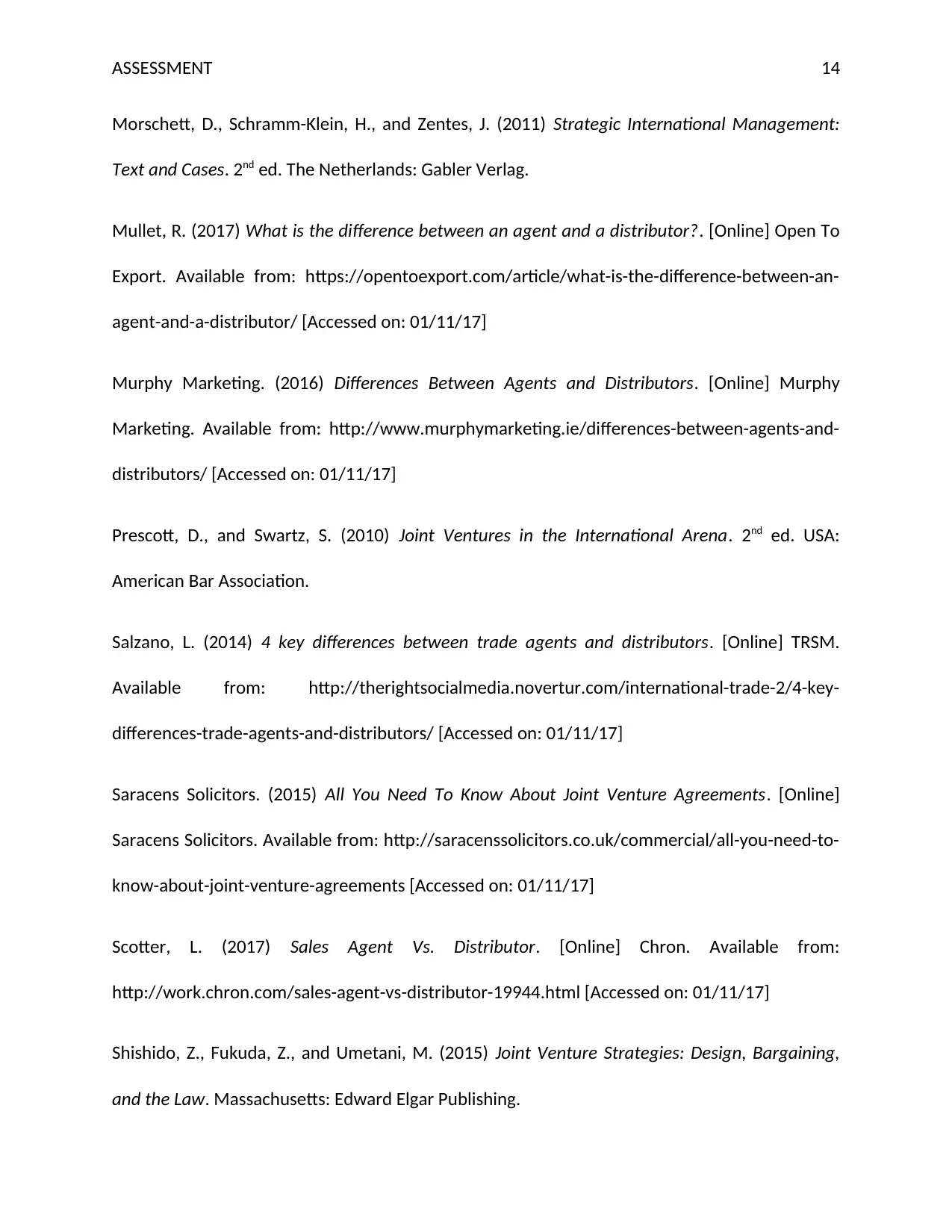
ASSESSMENT 14
Morschett, D., Schramm-Klein, H., and Zentes, J. (2011) Strategic International Management:
Text and Cases. 2nd ed. The Netherlands: Gabler Verlag.
Mullet, R. (2017) What is the difference between an agent and a distributor?. [Online] Open To
Export. Available from: https://opentoexport.com/article/what-is-the-difference-between-an-
agent-and-a-distributor/ [Accessed on: 01/11/17]
Murphy Marketing. (2016) Differences Between Agents and Distributors. [Online] Murphy
Marketing. Available from: http://www.murphymarketing.ie/differences-between-agents-and-
distributors/ [Accessed on: 01/11/17]
Prescott, D., and Swartz, S. (2010) Joint Ventures in the International Arena. 2nd ed. USA:
American Bar Association.
Salzano, L. (2014) 4 key differences between trade agents and distributors. [Online] TRSM.
Available from: http://therightsocialmedia.novertur.com/international-trade-2/4-key-
differences-trade-agents-and-distributors/ [Accessed on: 01/11/17]
Saracens Solicitors. (2015) All You Need To Know About Joint Venture Agreements. [Online]
Saracens Solicitors. Available from: http://saracenssolicitors.co.uk/commercial/all-you-need-to-
know-about-joint-venture-agreements [Accessed on: 01/11/17]
Scotter, L. (2017) Sales Agent Vs. Distributor. [Online] Chron. Available from:
http://work.chron.com/sales-agent-vs-distributor-19944.html [Accessed on: 01/11/17]
Shishido, Z., Fukuda, Z., and Umetani, M. (2015) Joint Venture Strategies: Design, Bargaining,
and the Law. Massachusetts: Edward Elgar Publishing.
Morschett, D., Schramm-Klein, H., and Zentes, J. (2011) Strategic International Management:
Text and Cases. 2nd ed. The Netherlands: Gabler Verlag.
Mullet, R. (2017) What is the difference between an agent and a distributor?. [Online] Open To
Export. Available from: https://opentoexport.com/article/what-is-the-difference-between-an-
agent-and-a-distributor/ [Accessed on: 01/11/17]
Murphy Marketing. (2016) Differences Between Agents and Distributors. [Online] Murphy
Marketing. Available from: http://www.murphymarketing.ie/differences-between-agents-and-
distributors/ [Accessed on: 01/11/17]
Prescott, D., and Swartz, S. (2010) Joint Ventures in the International Arena. 2nd ed. USA:
American Bar Association.
Salzano, L. (2014) 4 key differences between trade agents and distributors. [Online] TRSM.
Available from: http://therightsocialmedia.novertur.com/international-trade-2/4-key-
differences-trade-agents-and-distributors/ [Accessed on: 01/11/17]
Saracens Solicitors. (2015) All You Need To Know About Joint Venture Agreements. [Online]
Saracens Solicitors. Available from: http://saracenssolicitors.co.uk/commercial/all-you-need-to-
know-about-joint-venture-agreements [Accessed on: 01/11/17]
Scotter, L. (2017) Sales Agent Vs. Distributor. [Online] Chron. Available from:
http://work.chron.com/sales-agent-vs-distributor-19944.html [Accessed on: 01/11/17]
Shishido, Z., Fukuda, Z., and Umetani, M. (2015) Joint Venture Strategies: Design, Bargaining,
and the Law. Massachusetts: Edward Elgar Publishing.
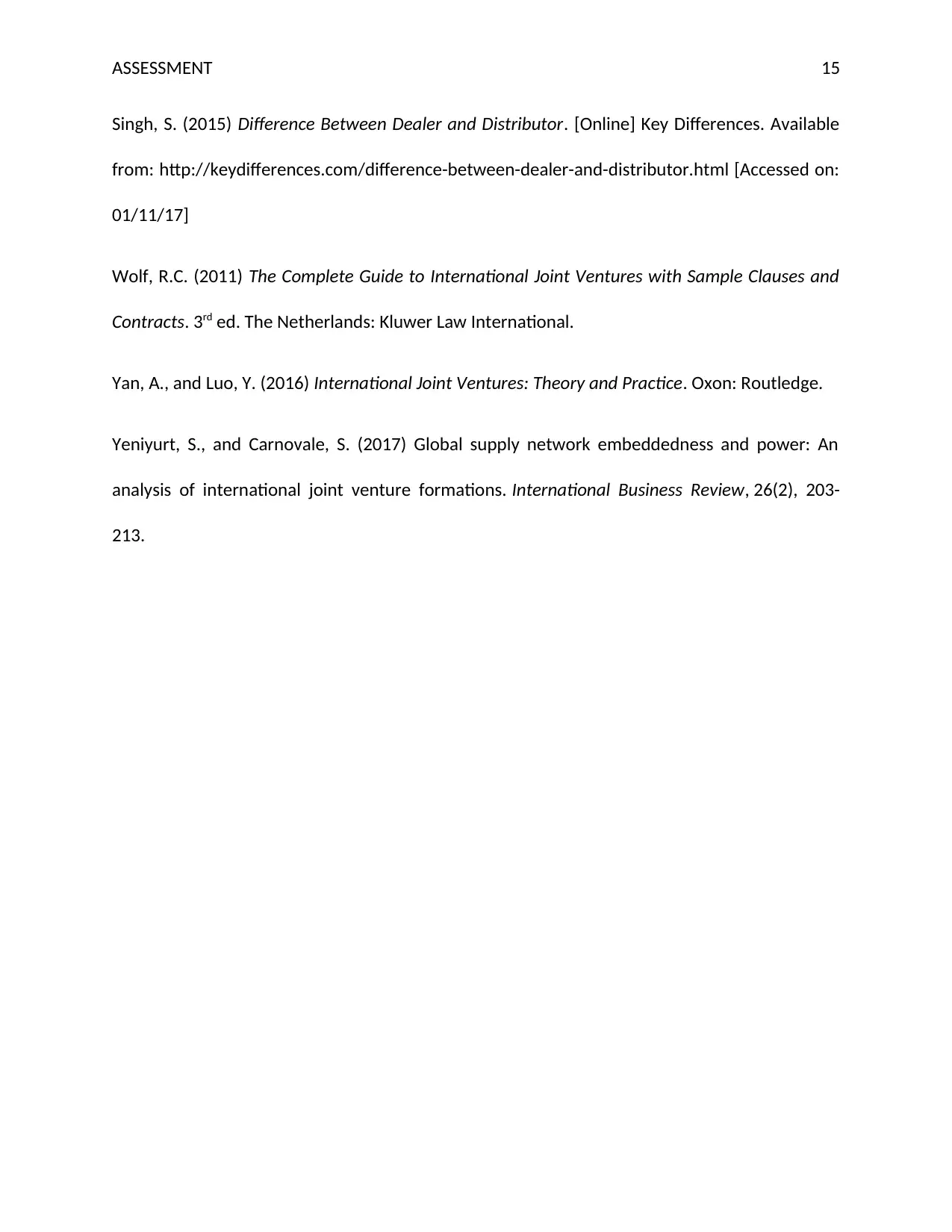
ASSESSMENT 15
Singh, S. (2015) Difference Between Dealer and Distributor. [Online] Key Differences. Available
from: http://keydifferences.com/difference-between-dealer-and-distributor.html [Accessed on:
01/11/17]
Wolf, R.C. (2011) The Complete Guide to International Joint Ventures with Sample Clauses and
Contracts. 3rd ed. The Netherlands: Kluwer Law International.
Yan, A., and Luo, Y. (2016) International Joint Ventures: Theory and Practice. Oxon: Routledge.
Yeniyurt, S., and Carnovale, S. (2017) Global supply network embeddedness and power: An
analysis of international joint venture formations. International Business Review, 26(2), 203-
213.
Singh, S. (2015) Difference Between Dealer and Distributor. [Online] Key Differences. Available
from: http://keydifferences.com/difference-between-dealer-and-distributor.html [Accessed on:
01/11/17]
Wolf, R.C. (2011) The Complete Guide to International Joint Ventures with Sample Clauses and
Contracts. 3rd ed. The Netherlands: Kluwer Law International.
Yan, A., and Luo, Y. (2016) International Joint Ventures: Theory and Practice. Oxon: Routledge.
Yeniyurt, S., and Carnovale, S. (2017) Global supply network embeddedness and power: An
analysis of international joint venture formations. International Business Review, 26(2), 203-
213.
1 out of 15
Related Documents
Your All-in-One AI-Powered Toolkit for Academic Success.
+13062052269
info@desklib.com
Available 24*7 on WhatsApp / Email
![[object Object]](/_next/static/media/star-bottom.7253800d.svg)
Unlock your academic potential
© 2024 | Zucol Services PVT LTD | All rights reserved.





